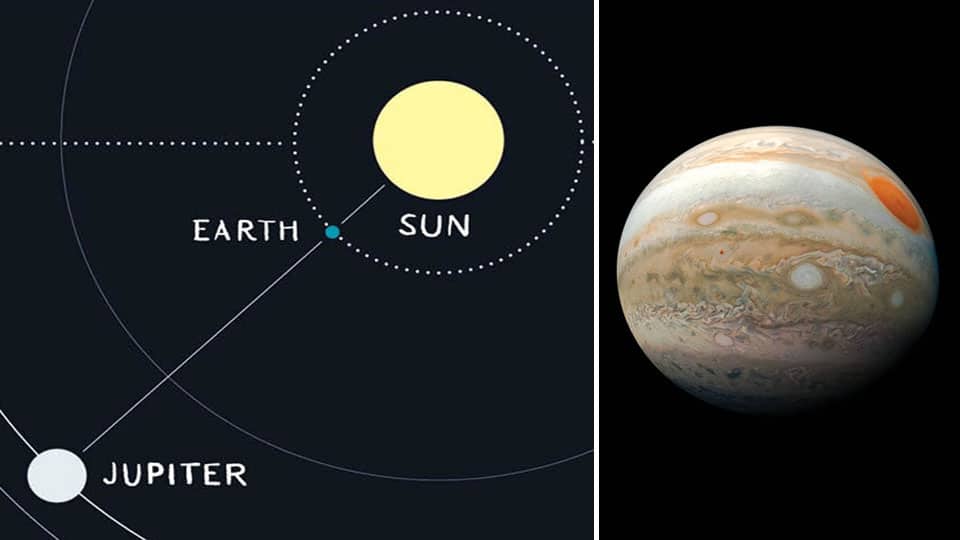Jupiter is the most resplendent bluish-yellow planet in the Solar System and is regarded as the biggest planet. In 2019, Jupiter will prolong to dominate the night sky during June, July and August.
Jupiter, the monster planet, is reaching ‘Opposition’ on June 10.
‘Opposition’ is the astronomical occurrence when a planet farther from the Sun than Earth appears opposite the Sun in the sky. On this date, planet Earth flies between the Sun and the gas giant Jupiter.
On June 10, Jupiter, the fifth planet from the Sun, will be nearest to Earth and could be the brightest celestial object on that day. During planetary opposition, the planet is up entire night and generally closest for the year.
Jupiter is the second brightest planet after Venus. A few weeks before and after the opposition on June 2019, Jupiter will be very bright, reaching a visual magnitude of about -2.5 to -2.6.
This will be an excellent opportunity to observe Jupiter, its Great Red Spot and Jupiter’s four largest satellites namely Io, Europa, Ganymede and Callisto. These celebrated satellites of Jupiter can be seen in a binocular also. A telescope with a magnification of 40 times or above is preferred in observing Jupiter.
Visual magnitude is a measure of the brightness of a celestial object. The visual magnitude of a faint star is large and positive. The brighter a star is, the smaller the visual magnitude will be. In a clear night, the faintest stars that can be observed by naked eyes in the countryside would have a magnitude of around +6. The apparent magnitude or brightness factor of Jupiter during June and July is -2.6. [Note: Negative sign convention indicates that, the brightness will be maximum and for the positive sign convention, the brightness will be minimum]
From Mysuru, Jupiter will be perceptible between 19:46 to 05:29 or evening 7:46 pm to morning 5:29 am. It reaches the highest point or pinnacle in the sky at around midnight local time.
Jupiter can be seen in the vicinity of first magnitude star ‘Antares,’ the brightest star in the constellation ‘Scorpius’ and Antares is often confused as Jupiter. Generally, Jupiter reaches opposition about every 13 months and the next ‘Opposition of Jupiter’ is on July 14, 2020. The distance between Jupiter and Earth on June 10 shall be 640.9 million kilometres.
At around 11.30 pm, Jupiter will reach the highest point in June and this planet stands 20 degrees before the end of twilight. The most interesting aspect during the observation of Jupiter is ‘Great Red Spot’. This iconic spot has been shrinking over the past several decades and currently spans about 1.3 Earths, but is remains colourful and easy to see at 100x magnification and higher in good seeing. The Great Red Spot maintains its orange-red hue in recent years, a colour shared by the sulphur-encrusted, volcanic satellite of Jupiter Io, the only of the bright satellite of Jupiter to show a distinctive colour.
Jupiter was visible in the morning sky from the first week of January just before sunrise in the constellation ‘Sagittarius’ in which it remains almost throughout the year. Presently, Jupiter is clearly perceptible in the south eastern direction at about 8:00 pm from all parts of the country in the constellation ‘Ophiuchus’.
Slightly below Jupiter in the same direction, Saturn can be seen as white dot. Jupiter revolves around the Sun with a period of about 11.86 years. In ancient China, the year was counted according to the position of Jupiter on the celestial sphere, and matched to the 12 Earthly Branches. So Jupiter is also known as the Age Star. Opposition of Jupiter will occur about once every 399 days.
Absolutely no telescope is required to enjoy the pulchritude of Jupiter. Jupiter is effortlessly discernible, as a bright watermelon-colored star rising in the East after sunset, can be found virtually overhead at midnight, and sets in the West at dawn. Never forget to witness Jupiter on June 10 and do enjoy the grandeur and magnanimity of sky-watching.
– Dr. S.A. Mohan Krishna, Observational Astronomer








Recent Comments